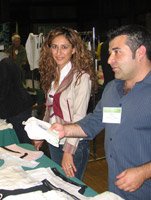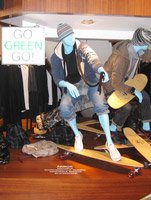Organic Exchange's Efforts Gather Steam
With 330 attendees from 39 countries, the Organic Exchange’s annual conference, held this year in Monterey, Calif., was a record success for the 5-year-old organization.
The three-day event, held Oct. 31– Nov. 2 at the historic Asilomar Conference Center, drew an international mix that included representatives from retailers Nordstrom, Marks & Spencer, Macy’s, H&M and Mango, as well as key players on the manufacturing side, including Nike and Patagonia, as well as smaller companies such as Eco-Ganik, BGreen and Econscious. The conference also drew representatives from the international farming community, as well as representatives of financial institutions that support small farms. Many of the farmers arrived a day early to discuss agriculture-specific issues and to get an update on the growth of the organic industry.
While Organic Exchange staff and conference attendees celebrated the five-year mark, many in the organization have been working on building interest in and awareness of organic and sustainable materials long before the formation of the nonprofit organization, based in Berkeley, Calif. Perhaps most significantly, the Organic Exchange has been building a global infrastructure that can support the growing interest in organic and sustainable materials.
“It used to be if you were passionate [about an idea], at best people thought you were weird. At worst they thought you were emotional. It’s not easy or comfortable to be a pioneer,” said Heidi McCloskey, director of communications and a founding member of the Organic Exchange. McCloskey also served as director of the sustainability department of Nike’s global apparel division, as well as corporate research and development manager for Nike’s Environmental Action Team.
Interest in apparel made from organic materials has been steadily growing. But the market saw a seismic shift when Wal-Mart and Sam’s Club entered the equation several years ago. The giant discount retailer has had the largest organic-cotton program in place for the past two years, surpassing early adopters Nike and Patagonia, as well as European cooperative supermarket chain Coop Switzerland. Last year, newcomers Woolworth’s South Africa and British discount retailer C&A joined the top-five players in the organic market with major programs. Representatives from Woolworth’s and C&A were on hand at the conference.
Worldwide, the market for organic cotton products—including apparel, home textiles and personal-care products—topped $1 billion in retail sales in 2006, according to the Organic Exchange’s “Organic Cotton Market Report.” This year the Organic Exchange is projecting the organic market will reach $2 billion, and by 2008 it will reach $3.5 billion.
The organic-apparel and home-textile market is about half the size of the overall organic market. Retail sales of organic food, fiber and personal-care products reached $4 billion in 2007, according to the Soil Association, a 61-year-old organization based in the United Kingdom that was founded to promote the use and certification of organic food and farming. It was the growing market for organic goods that drew attendees to the conference, where organizers provided a full slate of seminars focusing on overview issues, including climate change, water conservation and profiling the eco consumer. The seminars gave specific information on organic standards labeling, new organic materials, and developments in dyeing and finishing, as well as the effect of genetically modified seed usage on organic farming.
“The 8,000-pound gorilla is climate change,” said David Bennell, executive director of the Forest Stewardship Council Foundation Global Fund, an investor- led grant-making group founded to support sustainable forestry initiatives.
“Organic farming offers more climate-change mitigation,” Bennell added, citing research released in May at the International Conference on Organic Agriculture and Food Security in Rome.
“As we all know, cotton is a very thirsty crop,” said Sarah Severn, Nike’s director of sustainability horizons. “At Nike, our businesses are predicated on cheap oil,” she added, noting that rising oil prices will not only have an impact on shipping, but also on the cost of petroleum-based man-made fibers.
Impacting the market is the availability of organic cotton.
“The big question is: ’Is there enough fiber?’ said LaRhea Pepper, executive director of the Organic Exchange. “The next six to nine months, as people make their planting decisions, will determine if we can meet supply.”
The Organic Exchange has set a goal of increasing land under cultivation for organic cotton by 50 percent each year—a goal, which, so far, has been met.
Organic cotton was grown in 24 countries last year, according to the Organic Exchange, which saw a 53 percent increase in organic cotton farming. India, where organic cotton production grew by 57 percent, is set to be the largest organic cotton producer in the world, according to the organization. In Africa, production grew 83 percent between 2005/06 and 2006/07. Another growing center for organic cotton is Latin America, where the crop, including the cultivation of colored cotton, is grown in Peru, Brazil, Paraguay, Nicaragua and Colombia.
By working directly with farmers and farming cooperatives, the Organic Exchange hopes to achieve several goals: to increase the supply of global organic cotton, to ensure that organic standards are being met from the very beginning of the supply chain and to provide makers of organic products with a marketing message for their consumers.
“I think consumers are going to get a lot more savvy about where garments come from, and I think they are going to want a back story,” said Nike’s Severn, adding that having a transparent supply chain will become more important for all manufacturers in all industries. “I think traceability is going to be an important factor. And I think this community is a lot further ahead [in this regard].”
Nordstom’s eco=strategy
When Nordstrom first began looking into adding organic products, there was not much demand from consumers, according to Joan Mudget, vice president of supply chain for the Seattle specialty retailer, who said the company started with one private-label program and slowing grew from there.
“By the time we fully implemented the program, we hoped the customer would be asking for it,” she said. Currently Nordstrom plans to devote 3 percent of its product mix to organic materials, Mudget said, adding that eventually the retailer wants to grow that amount to 20 percent.
But when Mudget was getting the program off the ground, she said, Nordstrom had to change how it traditionally sourced its private-label programs.
“Our primary relationship was with the cut-and-sew manufacturers,” she explained. “We had to work backwards and say, ’Can you bring your mill to the table? Can you bring your yarn spinner to the table? Can you bring your cotton merchant?’”
In order to ensure consistent supply of organic cotton, Nordstrom struck a contract with its cotton merchants to guarantee a certain quantity for future delivery. “We projected our needs, and they guaranteed certain prices including certification and standard of quality.”
Some of the conference’s participants got a chance to see the breadth of Nordstrom’s organic offerings during a retail tour of San Francisco organized by the Organic Exchange. The group stopped by the California College of the Arts before visiting several stores in UnionSquare, including the new Barneys New York, Nordstrom and Origins.
The Organic Exchange also took a second group south to tour several organic farms.
Organized and Organic
The Organic Exchange is a nonprofit founded to encourage the increase in organic agriculture and production and the use of organically grown fibers. The group has set—and, so far, achieved—a goal of increasing the amount of land used for certified organic farming by 50 percent each year. Through its annual conference, regional meetings, Web site and offices in Berkeley, Calif., and O’Donnell, Texas, the organization brings together brands, retailers, farmers and other “key stakeholders” to educate them about the benefits of organic agriculture and to develop new business practices related to the cultivation and use of organic materials. The group also has set a goal of educating the end consumer about the value of organic agriculture and the availability of organic products.
The Organic Exchange is separate from the Organic Trade Association, a 13-year-old trade organization that was also founded to promote and protect the organic industry from farmer to mill to producer to retailer to end consumer. OTA members include businesses in the food, fiber/textile and personal-care-product fields. One of the focus areas for the OTA is the development, protection and verification of organic standards, including standards affecting organic farming, as well as the production and labeling of organic products.
The OTA maintains several informational Web sites, including its own (www.ota.com); a Web site for farmers and businesses interested in becoming organic or interested launching a new organic business (www.howtogoorganic.com); and a consumer Web site (www.theorganicreport.com). The group maintains a directory of organic businesses, “The Organic Pages Online,” and publishes a media newsletter, What’s News in Organic,” as well as promotes organic products at several consumer and trade events, including its own conference and trade show, All Things Organic.
























